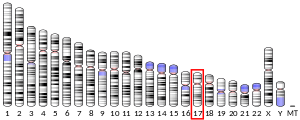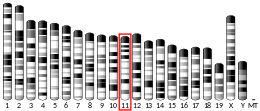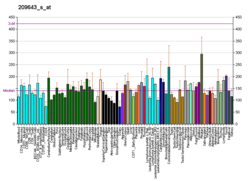PLD2
Phospholipase D2 is an enzyme that in humans is encoded by the PLD2 gene.[5][6]
Function
Phosphatidylcholine (PC)-specific phospholipases D (PLDs) catalyze the hydrolysis of PC to produce phosphatidic acid and choline. Activation of PC-specific PLDs occurs as a consequence of agonist stimulation of both tyrosine kinase and G protein-coupled receptors. PC-specific PLDs have been proposed to function in regulated secretion, cytoskeletal reorganization, transcriptional regulation, and cell cycle control.[supplied by OMIM][7]
Mechanism of activation
PLD2 is activate by substrate presentation.[8] The enzyme is palmitoylated which drives PLD2 to lipid rafts. PC substrate is polyunsaturated and resides in the membrane separately from lipid rafts near phosphatidylinositol 4,5-bisphosphate (PIP2). When PIP2 levels increase, PLD2 trafficks to PIP2 where it encounters its substrate PC. Scaffolding proteins that interact with PLD2 likely changes its preference lipid rafts vs PIP2.
Interactions
PLD2 has been shown to interact with:
- ARF1,[9][10]
- Aldolase A,[11]
- Amphiphysin,[12]
- BIN1,[12]
- Caveolin 1,[13][14]
- Glyceraldehyde 3-phosphate dehydrogenase,[15]
- PLCG1,[16]
- PRKCD,[17]
- Src,[18] and
- Wiskott-Aldrich syndrome protein.[19]
Inhibitors
- N-(2-(1-(3-fluorophenyl)-4-oxo-1,3,8-triazaspiro[4.5]decan-8-yl)ethyl)-2-naphthamide: 75-fold selective versus PLD1, IC50 = 20 nM.[20]
References
- GRCh38: Ensembl release 89: ENSG00000129219 - Ensembl, May 2017
- GRCm38: Ensembl release 89: ENSMUSG00000020828 - Ensembl, May 2017
- "Human PubMed Reference:". National Center for Biotechnology Information, U.S. National Library of Medicine.
- "Mouse PubMed Reference:". National Center for Biotechnology Information, U.S. National Library of Medicine.
- Park SH, Ryu SH, Suh PG, Kim H (February 1999). "Assignment of human PLD2 to chromosome band 17p13.1 by fluorescence in situ hybridization". Cytogenetics and Cell Genetics. 82 (3–4): 225. doi:10.1159/000015106. PMID 9858823.
- Lopez I, Arnold RS, Lambeth JD (May 1998). "Cloning and initial characterization of a human phospholipase D2 (hPLD2). ADP-ribosylation factor regulates hPLD2". The Journal of Biological Chemistry. 273 (21): 12846–52. doi:10.1074/jbc.273.21.12846. PMID 9582313.
- "Entrez Gene: PLD2 phospholipase D2".
- Petersen EN, Chung HW, Nayebosadri A, Hansen SB (December 2016). "Kinetic disruption of lipid rafts is a mechanosensor for phospholipase D". Nature Communications. 7: 13873. Bibcode:2016NatCo...713873P. doi:10.1038/ncomms13873. PMC 5171650. PMID 27976674.
- Lee S, Park JB, Kim JH, Kim Y, Kim JH, Shin KJ, et al. (July 2001). "Actin directly interacts with phospholipase D, inhibiting its activity". The Journal of Biological Chemistry. 276 (30): 28252–60. doi:10.1074/jbc.M008521200. PMID 11373276.
- Park JB, Kim JH, Kim Y, Ha SH, Yoo JS, Du G, et al. (July 2000). "Cardiac phospholipase D2 localizes to sarcolemmal membranes and is inhibited by alpha-actinin in an ADP-ribosylation factor-reversible manner". The Journal of Biological Chemistry. 275 (28): 21295–301. doi:10.1074/jbc.M002463200. PMID 10801846.
- Kim JH, Lee S, Kim JH, Lee TG, Hirata M, Suh PG, Ryu SH (March 2002). "Phospholipase D2 directly interacts with aldolase via Its PH domain". Biochemistry. 41 (10): 3414–21. doi:10.1021/bi015700a. PMID 11876650.
- Lee C, Kim SR, Chung JK, Frohman MA, Kilimann MW, Rhee SG (June 2000). "Inhibition of phospholipase D by amphiphysins". The Journal of Biological Chemistry. 275 (25): 18751–8. doi:10.1074/jbc.M001695200. PMID 10764771.
- Zheng X, Bollinger Bollag W (December 2003). "Aquaporin 3 colocates with phospholipase d2 in caveolin-rich membrane microdomains and is downregulated upon keratinocyte differentiation". The Journal of Investigative Dermatology. 121 (6): 1487–95. doi:10.1111/j.1523-1747.2003.12614.x. PMID 14675200.
- Czarny M, Fiucci G, Lavie Y, Banno Y, Nozawa Y, Liscovitch M (February 2000). "Phospholipase D2: functional interaction with caveolin in low-density membrane microdomains". FEBS Letters. 467 (2–3): 326–32. doi:10.1016/s0014-5793(00)01174-1. PMID 10675563.
- Kim JH, Lee S, Park JB, Lee SD, Kim JH, Ha SH, et al. (June 2003). "Hydrogen peroxide induces association between glyceraldehyde 3-phosphate dehydrogenase and phospholipase D2 to facilitate phospholipase D2 activation in PC12 cells". Journal of Neurochemistry. 85 (5): 1228–36. doi:10.1046/j.1471-4159.2003.01755.x. PMID 12753082.
- Jang IH, Lee S, Park JB, Kim JH, Lee CS, Hur EM, et al. (May 2003). "The direct interaction of phospholipase C-gamma 1 with phospholipase D2 is important for epidermal growth factor signaling". The Journal of Biological Chemistry. 278 (20): 18184–90. doi:10.1074/jbc.M208438200. PMID 12646582.
- Han JM, Kim JH, Lee BD, Lee SD, Kim Y, Jung YW, et al. (March 2002). "Phosphorylation-dependent regulation of phospholipase D2 by protein kinase C delta in rat Pheochromocytoma PC12 cells". The Journal of Biological Chemistry. 277 (10): 8290–7. doi:10.1074/jbc.M108343200. PMID 11744693.
- Ahn BH, Kim SY, Kim EH, Choi KS, Kwon TK, Lee YH, et al. (May 2003). "Transmodulation between phospholipase D and c-Src enhances cell proliferation". Molecular and Cellular Biology. 23 (9): 3103–15. doi:10.1128/mcb.23.9.3103-3115.2003. PMC 153190. PMID 12697812.
- Kantonen S, Hatton N, Mahankali M, Henkels KM, Park H, Cox D, Gomez-Cambronero J (November 2011). "A novel phospholipase D2-Grb2-WASp heterotrimer regulates leukocyte phagocytosis in a two-step mechanism". Molecular and Cellular Biology. 31 (22): 4524–37. doi:10.1128/MCB.05684-11. PMC 3209255. PMID 21930784.
- Lavieri RR, Scott SA, Selvy PE, Kim K, Jadhav S, Morrison RD, et al. (September 2010). "Design, synthesis, and biological evaluation of halogenated N-(2-(4-oxo-1-phenyl-1,3,8-triazaspiro[4.5]decan-8-yl)ethyl)benzamides: discovery of an isoform-selective small molecule phospholipase D2 inhibitor". Journal of Medicinal Chemistry. 53 (18): 6706–19. doi:10.1021/jm100814g. PMC 3179181. PMID 20735042.
Further reading
- Sundaram M, Cook HW, Byers DM (February 2004). "The MARCKS family of phospholipid binding proteins: regulation of phospholipase D and other cellular components". Biochemistry and Cell Biology. 82 (1): 191–200. doi:10.1139/o03-087. PMID 15052337.
- McDermott M, Wakelam MJ, Morris AJ (February 2004). "Phospholipase D". Biochemistry and Cell Biology. 82 (1): 225–53. doi:10.1139/o03-079. PMID 15052340.
- Colley WC, Sung TC, Roll R, Jenco J, Hammond SM, Altshuller Y, et al. (March 1997). "Phospholipase D2, a distinct phospholipase D isoform with novel regulatory properties that provokes cytoskeletal reorganization". Current Biology. 7 (3): 191–201. doi:10.1016/S0960-9822(97)70090-3. PMID 9395408.
- Steed PM, Clark KL, Boyar WC, Lasala DJ (October 1998). "Characterization of human PLD2 and the analysis of PLD isoform splice variants". FASEB Journal. 12 (13): 1309–17. doi:10.1096/fasebj.12.13.1309. PMID 9761774.
- Slaaby R, Jensen T, Hansen HS, Frohman MA, Seedorf K (December 1998). "PLD2 complexes with the EGF receptor and undergoes tyrosine phosphorylation at a single site upon agonist stimulation". The Journal of Biological Chemistry. 273 (50): 33722–7. doi:10.1074/jbc.273.50.33722. PMID 9837959.
- Czarny M, Fiucci G, Lavie Y, Banno Y, Nozawa Y, Liscovitch M (February 2000). "Phospholipase D2: functional interaction with caveolin in low-density membrane microdomains". FEBS Letters. 467 (2–3): 326–32. doi:10.1016/S0014-5793(00)01174-1. PMID 10675563.
- Lee C, Kim SR, Chung JK, Frohman MA, Kilimann MW, Rhee SG (June 2000). "Inhibition of phospholipase D by amphiphysins". The Journal of Biological Chemistry. 275 (25): 18751–8. doi:10.1074/jbc.M001695200. PMID 10764771.
- Park JB, Kim JH, Kim Y, Ha SH, Yoo JS, Du G, et al. (July 2000). "Cardiac phospholipase D2 localizes to sarcolemmal membranes and is inhibited by alpha-actinin in an ADP-ribosylation factor-reversible manner". The Journal of Biological Chemistry. 275 (28): 21295–301. doi:10.1074/jbc.M002463200. PMID 10801846.
- Zhang Y, Redina O, Altshuller YM, Yamazaki M, Ramos J, Chneiweiss H, et al. (November 2000). "Regulation of expression of phospholipase D1 and D2 by PEA-15, a novel protein that interacts with them". The Journal of Biological Chemistry. 275 (45): 35224–32. doi:10.1074/jbc.M003329200. PMID 10926929.
- Morash SC, Byers DM, Cook HW (September 2000). "Activation of phospholipase D by PKC and GTPgammaS in human neuroblastoma cells overexpressing MARCKS". Biochimica et Biophysica Acta (BBA) - Molecular and Cell Biology of Lipids. 1487 (2–3): 177–89. doi:10.1016/s1388-1981(00)00094-9. PMID 11018470.
- Divecha N, Roefs M, Halstead JR, D'Andrea S, Fernandez-Borga M, Oomen L, et al. (October 2000). "Interaction of the type Ialpha PIPkinase with phospholipase D: a role for the local generation of phosphatidylinositol 4, 5-bisphosphate in the regulation of PLD2 activity". The EMBO Journal. 19 (20): 5440–9. doi:10.1093/emboj/19.20.5440. PMC 314009. PMID 11032811.
- Slaaby R, Du G, Altshuller YM, Frohman MA, Seedorf K (November 2000). "Insulin-induced phospholipase D1 and phospholipase D2 activity in human embryonic kidney-293 cells mediated by the phospholipase C gamma and protein kinase C alpha signalling cascade". The Biochemical Journal. 351 Pt 3 (3): 613–9. doi:10.1042/0264-6021:3510613. PMC 1221400. PMID 11042115.
- Hartley JL, Temple GF, Brasch MA (November 2000). "DNA cloning using in vitro site-specific recombination". Genome Research. 10 (11): 1788–95. doi:10.1101/gr.143000. PMC 310948. PMID 11076863.
- Lee S, Park JB, Kim JH, Kim Y, Kim JH, Shin KJ, et al. (July 2001). "Actin directly interacts with phospholipase D, inhibiting its activity". The Journal of Biological Chemistry. 276 (30): 28252–60. doi:10.1074/jbc.M008521200. PMID 11373276.
- Sarkar S, Miwa N, Kominami H, Igarashi N, Hayashi S, Okada T, et al. (November 2001). "Regulation of mammalian phospholipase D2: interaction with and stimulation by G(M2) activator". The Biochemical Journal. 359 (Pt 3): 599–604. doi:10.1042/0264-6021:3590599. PMC 1222181. PMID 11672434.
- Denmat-Ouisse LA, Phebidias C, Honkavaara P, Robin P, Geny B, Min DS, et al. (December 2001). "Regulation of constitutive protein transit by phospholipase D in HT29-cl19A cells". The Journal of Biological Chemistry. 276 (52): 48840–6. doi:10.1074/jbc.M104276200. PMID 11687572.
- Lee S, Kim JH, Lee CS, Kim JH, Kim Y, Heo K, et al. (February 2002). "Collapsin response mediator protein-2 inhibits neuronal phospholipase D(2) activity by direct interaction". The Journal of Biological Chemistry. 277 (8): 6542–9. doi:10.1074/jbc.M108047200. PMID 11741937.
- Han JM, Kim JH, Lee BD, Lee SD, Kim Y, Jung YW, et al. (March 2002). "Phosphorylation-dependent regulation of phospholipase D2 by protein kinase C delta in rat Pheochromocytoma PC12 cells". The Journal of Biological Chemistry. 277 (10): 8290–7. doi:10.1074/jbc.M108343200. PMID 11744693.




